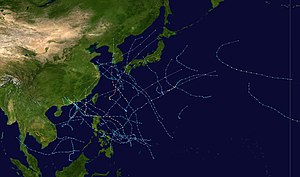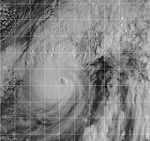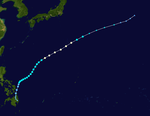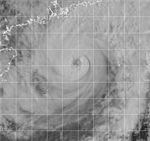1999 Pacific typhoon season
| 1999 Pacific typhoon season |

Season summary map
|
| Seasonal boundaries |
| First system formed |
January 3, 1999 |
| Last system dissipated |
December 16, 1999 |
| Strongest storm |
|
| Name |
Bart |
| • Maximum winds |
165 km/h (105 mph)
(10-minute sustained) |
| • Lowest pressure |
930 hPa (mbar) |
| Seasonal statistics |
| Total depressions |
45 |
| Total storms |
20 |
| Typhoons |
5 |
| Super typhoons |
1 |
| Total fatalities |
At least 976 |
| Total damage |
$18.36 billion (1999 USD) |
| Related articles |
|
|
Pacific typhoon seasons
1997, 1998, 1999, 2000, 2001
|
| Tropical depression (JMA) |
| Tropical storm (SSHWS) |
|
|
| Duration |
January 3 – January 8 |
| Peak intensity |
55 km/h (35 mph) (10-min) 1000 hPa (mbar) |
| Tropical depression (JMA) |
| Tropical storm (SSHWS) |
|
|
| Duration |
February 14 – February 19 |
| Peak intensity |
55 km/h (35 mph) (10-min) 1000 hPa (mbar) |
| Tropical depression (JMA) |
| Tropical storm (SSHWS) |
|
|
| Duration |
April 6 – April 9 |
| Peak intensity |
55 km/h (35 mph) (10-min) 1006 hPa (mbar) |
| Severe tropical storm (JMA) |
| Category 1 typhoon (SSHWS) |
|
|
| Duration |
April 21 – April 28 |
| Peak intensity |
100 km/h (65 mph) (10-min) 980 hPa (mbar) |
| Typhoon (JMA) |
| Category 3 typhoon (SSHWS) |
|
|
| Duration |
April 27 – May 2 |
| Peak intensity |
120 km/h (75 mph) (10-min) 970 hPa (mbar) |
| Typhoon (JMA) |
| Category 3 typhoon (SSHWS) |
|
|
| Duration |
June 1 – June 9 |
| Peak intensity |
140 km/h (85 mph) (10-min) 955 hPa (mbar) |
| Tropical depression (JMA) |
|
|
| Duration |
June 3 – June 6 |
| Peak intensity |
55 km/h (35 mph) (10-min) 996 hPa (mbar) |
| Tropical storm (JMA) |
| Tropical depression (SSHWS) |
|
|
| Duration |
July 14 – July 18 |
| Peak intensity |
65 km/h (40 mph) (10-min) 996 hPa (mbar) |
| Tropical depression (SSHWS) |
|
|
| Duration |
July 19 – July 23 |
| Peak intensity |
55 km/h (35 mph) (1-min) 1004 hPa (mbar) |
The 1999 Pacific typhoon season was the last Pacific typhoon season to use English names as storm names. It had no official bounds; it ran year-round in 1999, but most tropical cyclones tend to form in the northwestern Pacific Ocean between May and November. These dates conventionally delimit the period of each year when most tropical cyclones form in the northwestern Pacific Ocean.
The scope of this article is limited to the Pacific Ocean, north of the equator and west of the international date line. Storms that form east of the date line and north of the equator are called hurricanes; see 1999 Pacific hurricane season. Tropical Storms formed in the entire west Pacific basin were assigned a name by the Joint Typhoon Warning Center. Tropical depressions in this basin have the "W" suffix added to their number. Tropical depressions that enter or form in the Philippine area of responsibility are assigned a name by the Philippine Atmospheric, Geophysical and Astronomical Services Administration or PAGASA. This can often result in the same storm having two names.
In the storm information below, the Joint Typhoon Warning Center (JTWC) wind-speed advisories differ than that of the Japan Meteorological Agency (JMA) because the JTWC uses the United States criteria of 1-minute sustained winds to designate a tropical cyclone's maximum sustained winds, whereas the JMA uses 10-minute sustained winds to determine maximum sustained winds. Consequently, in most cases, the JTWC maximum winds for a cyclone appear higher than the JMA's estimated maximum winds for the same system.
The JTWC issued a Tropical Cyclone Formation Alert (TCFA) for a developing broad circulation that stretched out from the northwest Borneo coast early on January 4. This developed into a tropical depression and moved slowly to the north away from Borneo, becoming Tropical Storm Hilda early on January 6. Soon after reaching its peak strength of 65 km/h (40 mph) Hilda drifted further north into an area of increased wind shear, which caused the storm to dissipate the next day. Both JMA and PAGASA tracked this system, but considered it a tropical depression. PAGASA named the storm Auring.
...
Wikipedia


















